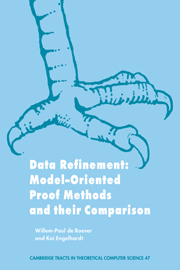Book contents
- Frontmatter
- Contents
- Preface
- Part I Theory
- 1 Introduction to Data Refinement
- 2 Simulation as a Proof Method for Data Refinement
- 3 Relations and Recursion
- 4 Properties of Simulation
- 5 Notation and Semantics
- 6 A Hoare Logic
- 7 Simulation and Hoare Logic
- 8 An Extension to Total Correctness
- 9 Simulation and Total Correctness
- 10 Refinement Calculus
- Picture Gallery
- Part II Applications
- Appendix A An Introduction to Hoare Logic
- Appendix B A Primer on Ordinals and Transfinite Induction
- Appendix C Notational Convention
- Appendix D Precedences
- Bibliography
- Index
1 - Introduction to Data Refinement
Published online by Cambridge University Press: 03 May 2010
- Frontmatter
- Contents
- Preface
- Part I Theory
- 1 Introduction to Data Refinement
- 2 Simulation as a Proof Method for Data Refinement
- 3 Relations and Recursion
- 4 Properties of Simulation
- 5 Notation and Semantics
- 6 A Hoare Logic
- 7 Simulation and Hoare Logic
- 8 An Extension to Total Correctness
- 9 Simulation and Total Correctness
- 10 Refinement Calculus
- Picture Gallery
- Part II Applications
- Appendix A An Introduction to Hoare Logic
- Appendix B A Primer on Ordinals and Transfinite Induction
- Appendix C Notational Convention
- Appendix D Precedences
- Bibliography
- Index
Summary
Goal and Motivation
During the process of stepwise, hierarchical program development, a step represents a transformation of a so-called abstract higher level result into a more concrete lower level one. In general, this development process corresponds to increasing the amount of detail required for the eventual implementation of the original specification on a given machine.
In the first part of this book we develop the relational theory of simulation and a general version of Hoare logic, show how data refinement can be expressed within this logic, extend these results to total correctness, and show how all this theory can be uniformly expressed inside the refinement calculus of Ralph Back, Paul Gardiner, Carroll Morgan and Joakim von Wright. We develop this theory as a reference point for comparing various existing data refinement methods in the second part, some of which are syntax-based methods. This is one of the main reasons why we are forced to clearly separate syntax from semantics.
The second part of this monograph focuses on the introduction of, and comparison between, various methods for proving correctness of such transformation steps. Although these methods are illustrated mainly by applying them to correctness proofs of implementations of data types, the techniques developed apply equally well to proving correctness of such steps in general, because all these methods are only variations on one central theme: that of proof by simulation, of which we analyze at least 13 different formulations.
Information
- Type
- Chapter
- Information
- Data RefinementModel-Oriented Proof Methods and their Comparison, pp. 2 - 18Publisher: Cambridge University PressPrint publication year: 1998
Accessibility standard: Unknown
Why this information is here
This section outlines the accessibility features of this content - including support for screen readers, full keyboard navigation and high-contrast display options. This may not be relevant for you.Accessibility Information
- 1
- Cited by
